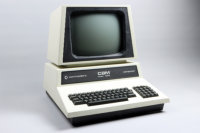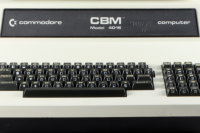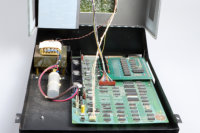Commodore CBM 4016 Computer, 1977 - 1982
2002/6.1


Revolution
The first home computers, like this Commodore CBM 4016, were products of technological advancements that saw the world shift from mechanical electronics to digital technology. The 1970s saw more technological change than any decade since the invention of the steam engine. Advancements in electrical current control made electronic devices more compact and complex.Holocaust
Pole, Jack Tramiel was born in 1928. Ten years later when Poland was invaded by Nazi Germany, Jack and his Jewish family were sent to Auschwitz. Jack survived the Holocaust and migrated to America. He started the Commodore Portable Typewriter company, which evolved to manufacture personal computers like this CBM 4016.Coders
Women played an important role developing the technology that led to this Commodore CBM 4016. The world’s first computer programmer was a woman. Ada Lovelace wrote an algorithm for a computing machine in the 1800s. When computers became a practical reality after World War Two, women were heavily involved in developing the code that allowed these machines to function.Geek
Before the 1970s, computers were mostly found in university labs. Home systems like this Commodore CBM 4016 offered more people the opportunity to learn programming, play games and connect with like-minded individuals and they captivated a generation of enthusiasts. The term “Geek”, formerly a circus freak show act, emerged to describe people with an obsessive interest in computers.

Commodore CBM 4016
Computer, 1977 - 1982
2002/6.1


Revolution
The first home computers, like this
Commodore CBM 4016, were products
of technological advancements that
saw the world shift from mechanical
electronics to digital technology.
The 1970s saw more technological
change than any decade since the
invention of the steam engine.
Advancements in electrical current
control made electronic devices more
compact and complex.
Holocaust
Pole, Jack Tramiel was born in 1928.
Ten years later when Poland was
invaded by Nazi Germany, Jack and
his Jewish family were sent to
Auschwitz. Jack survived the Holocaust
and migrated to America. He started
the Commodore Portable Typewriter
company, which evolved to
manufacture personal computers
like this CBM 4016.
Coders
Women played an important role
developing the technology that led
to this Commodore CBM 4016. The
world’s first computer programmer
was a woman. Ada Lovelace wrote an
algorithm for a computing machine in
the 1800s. When computers became
a practical reality after World War Two,
women were heavily involved in
developing the code that allowed
these machines to function.
Geek
Before the 1970s, computers were
mostly found in university labs. Home
systems like this Commodore CBM
4016 offered more people the
opportunity to learn programming,
play games and connect with like-
minded individuals and they captivated
a generation of enthusiasts. The term
“Geek”, formerly a circus freak show
act, emerged to describe people with
an obsessive interest in computers.


